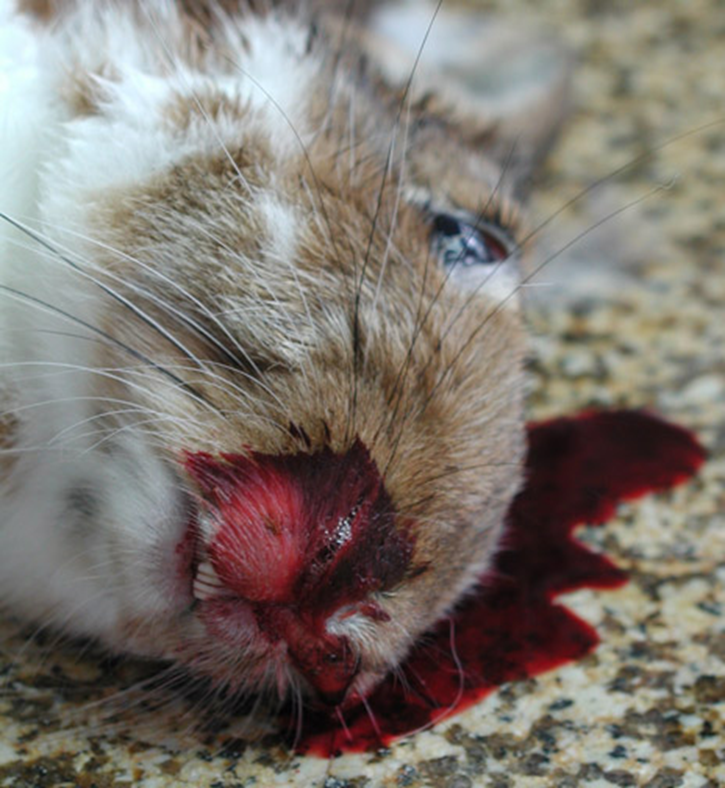Long Pham
Introduction
Rabbit hemorrhagic disease (RHD) is a highly contagious and lethal viral disease caused by a virus from the Caliciviridae family. This disease seems to only affect European rabbits (Oryctolagus cuniculus),both domesticated and wild rabbits. However, a newer strain of the virus, RHDV2, can affect rabbits with previous immunity to RHD and also hares (Lepus spp.).
The first outbreak of rabbit hemorrhagic disease was noted in China from a shipment of Angora rabbits from Germany in 1984 (1). The devastating nature of this disease can be seen as about 140 million domestic rabbits were killed in China during this outbreak in just less than a year (1). The next country to have an RHD outbreak was Korea due to importing rabbit fur from China (2). In 1986, the disease arrived in Italy and then spread to the rest of Europe (3). In 1988, the first outbreak in the Americas was reported in Mexico from imported rabbit products coming from China (4). However, Mexico was able to control RHD and had its last outbreak in 1992 (4). While RHD has been seen as a devastating disease that causes ecological and economical impacts, for New Zealand and Australia, RHD was considered as a method of pest control for the wild rabbits (5). Rabbit hemorrhagic disease virus was released in Wardang Island in South Australia, but in 1995, RHDV escaped and reach Australia (6). At the moment, RHD generally occurs in areas where European rabbits are found in the wild, with deadly outbreaks that can occur on almost all continents.
Clinical signs
Rabbit hemorrhagic disease virus has an incubation period of around 1-3 days. The virus can affect many internal organs (mainly targets the spleen, liver, and lungs), causing internal bleeding in infected rabbits. This disease can be present in 3 different forms: peracute, acute, subacute.
Peracute form: Infected rabbit dies suddenly without showing any signs. Can be seen functioning normally before suddenly dying.
Acute form: Rabbits can have a lack of motivation to move, ataxia, convulsions, subconjunctival hemorrhage, respiratory issues, and nosebleeds (Figure 1). For these infected rabbits, death can occur within 72 hours.
Subacute form: These rabbits can have the same symptoms, but in a milder form. In this form, liver damage can occur, causing jaundice, with death that can occur weeks later. In general, most rabbits survive and develop some immunity to the virus. In general, rabbits that have clinical symptoms will die from the disease, while rabbits with the subacute form may survive. Rabbits that recover from the subacute form may have extensive liver damage, resulting in chronic liver diseases.

Diagnosis
Rabbit hemorrhagic disease can be confirmed through a post-mortem examination for the presence of an enlarged and pale liver. Molecular testing of live samples with PCR or ELISA can also confirm diagnosis. However, some tests may not be able to distinguish between RHDV and RHDV2.
Figure 1: Rabbits with RHD often die suddenly and have bleeding from the nose due to internal bleeding. (Photo Credit: Dr. J.P. Teifke from theFederal Research Institute for Animal Health in Riems, Germany)
Treatment and Disease Control
Rabbit hemorrhagic disease have several possible routes of transmission: nasal, oral, conjunctival, and through other places because hematophagous insects have been seen to be quite effective in spreading diseases (7). Rabbit hemorrhagic disease virus may be shed through the rabbit’s excretions and secretions, making direct contact with or contact with contaminated environment the likely method of transmission. The remains of infected rabbits may also be a source of infections and spreading of the virus because it is very resilient and has been seen to still be viable even after three months (8). Flies and birds can also be effective carriers of the virus because they can travel great distances with the resilient virus and contaminate the rabbit’s food source and habitat. Carnivores and scavengers are other possible carriers because the virus from consumed infected rabbits can transported and spread through the feces.
Currently, there is no cure for rabbit hemorrhagic disease. Supportive care may help, but it’s best to have preventive care with vaccinations. Hyperimmune antiserum can be effective if the rabbit has not showed clinical signs, but will be ineffective after the signs appear. For domestic rabbits, vaccinations is an effective preventative measure. However, for wild rabbits, the sheer number of rabbits would make vaccinations economically unfeasible at the moment.
To help prevent outbreaks, countries can place bans or restrictions on importing rabbit products, such as meats or furs, from other countries where rabbit hemorrhagic disease is endemic. Other preventative methods are culling, monitoring, following strict quarantining rules, and thoroughly disinfecting contaminated areas before bringing rabbits there again.
Disinfection of the rabbit hemorrhagic disease virus can be done with a 4-10% solution of sodium hydroxide or 1-2% formalin solution. A 1:10 dilution of household bleach can also be used for disinfecting infected surfaces. However, since the virus is nonenveloped, an alcohol-based disinfection is not effective.
Reference
1. Liu, S. J., H. P. Xue, B. Q. Pu, and N. H. Qian. 1984. A new viral disease in rabbits. Animal Husbandry and Veterinary Medicine (Xumu yu Shouyi) 16:253–255.
2. Park, N.Y., C. Y. Chong, J. H. Kim, S. M. Cho, Y. H. Cha, B. T. Jung, D. S. Kim, J. B. Yoon, J. Y. Park, and S. H. Wee, 1987. An outbreak of viral haemorrhagic pneumonia (tentative name) of rabbits in Korea. Journal of the Korean Veterinary Medical Association: 23: 603-610.
3. Cancellotti, F. M., and M. Renzi. 1991. Epidemiology and current situation of viral haemorrhagic disease of rabbits and the European brown hare syndrome. Revue Scientifique et Technique de l’OIE 10:409–422.
4. Gregg, D. A., C. House, and M. Berninger. 1991. Viral haemorrhagic disease of rabbits in Mexico: Epidemiology and viral characterization. Revue Scientifique et Technique de l’OIE 10:435–451.
5. Cooke, B. D. 2002. Rabbit haemorrhagic disease: Field Epidemiology and the management of wild rabbit populations. Revue Scientifique et Technique de l’OIE 21:347–358.
6. Cooke, B. D., and F. Fenner. 2002. Rabbit haemorrhagic disease and the biological control of wild rabbits, oryctolagus cuniculus, in Australia and New Zealand. Wildlife Research 29:689–706.
7. Asgari, S., J. R. E. Hardy, R. G. Sinclair, and B. D. Cooke. 1998. Field evidence for mechanical transmission of rabbit haemorrhagic disease virus (RHDV) by flies (Diptera: Calliphoridae) among wild rabbits in Australia. Virus Research 54:123–132.
8. McColl, K. A., C. J. Morrissy, B. J. Collins, and H. A. Westbury. 2002. Persistence of rabbit haemorrhagic disease virus in decomposing rabbit carcases. Australian Veterinary Journal 80:298–299.



